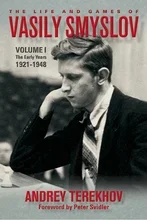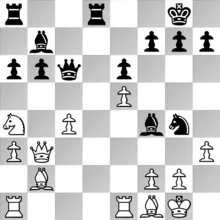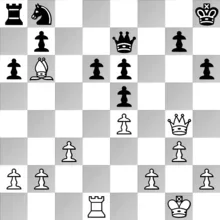International Master John Watson is often considered one of the world's leading authorities on chess literature. A fine author in his own right, with more than 30 books to his credit, Watson has long been regarded as one of chess' top critics as well. His reviews for The Week in Chess were legendary for their erudition, their completeness, and their honesty.
Watson took over the Chess Life review column in June 2020, appearing in print each month since then. Some chess fans have lamented the fact that Watson's reviews were no longer available on the web, and we have heard them. Therefore, in the interest of better serving the global chess community, US Chess has decided to make Watson's reviews available on uschess.org after a small window of exclusivity has passed. We beginning with his February review of a new book on GM Vasily Smyslov, born on this day 100 years ago, and whom a young, long-haired Watson once met in Lone Pine.
We will begin to fill in the backlog of Watson's reviews in the coming weeks. ~ed.
Of all the world champions, today’s players are probably least familiar with the career of Vasily Smyslov. And yet Smyslov was arguably more successful than many of his more renowned colleagues. This is shown by his many decades of sparkling tournament and Olympiad results, and even more so by his World Championship cycle achievements.
Smyslov finished second in the World Championship super-tournament of 1948, ahead of GMs Samuel Reshevsky, Paul Keres, and Max Euwe. He then won two of the strongest Candidates tournaments in history, the first in Zürich 1953, which led to a World Championship match versus GM Mikhail Botvinnik in 1954 (drawn 12-12), and the second in Amsterdam 1956, which culminated in winning the championship decisively (12½-9½) versus the same opponent in 1957.
Several commentators, including Kasparov, have opined that Smyslov was the world’s best player for most of the 1950s, surpassing even Botvinnik. He subsequently qualified for the Candidates four more times. Amazingly, at age 62, he finished second in the 1984 Las Palmas Interzonal, followed by winning two Candidates matches, and only a loss in the finals to GM Garry Kasparov prevented from playing in still another World Championship match. Subsequently, Smyslov continued to play successfully, won the World Senior Championship at age 70, and was rated almost 2500 when he played his last event at age 80!
Considering all this, surprisingly little has been written about Smyslov’s life and games. His own two-volume work Smyslov’s Best Games (the English version published by Moravian Chess in 2003) is extremely readable, but has little biographical information and the annotations are rather superficial and limited by modern standards.

There has long been a need for another book to do justice to Smyslov’s career, and the Russian FM Andrey Terekhov has devoted years of study and research to the task. Vasily Smyslov, Volume I: The Early Years: 1921-1948 is the first installment of what the author says will very likely be more than three volumes. The first volume has already vastly expanded our historical understanding, since Terekhov has unearthed countless previously unknown games and biographical facts from the pre-war and war years. This is a period from which records of Smyslov’s life were already scarce, a situation further exacerbated by the fact that a bomb destroyed the home where he lived at the time.
Terekhov includes both well-known and previously unpublished games. The annotations take into account Smyslov’s own notes and those by numerous other top-level players; this gives the reader a sense of Smyslov’s own thoughts and the real-world considerations involved in the heat of battle. Terekhov supplements this with computer-assisted analysis so that one gets to the truth of key positions, but he is careful to separate impossibly exotic lines from what was realistic for the players to find in practice.
Smyslov was a late starter and didn’t play a tournament game until he was 14; at that point, he quickly found his footing. In one of his first events he played a game that remained a sentimental favorite throughout his life:
Colle System (D05)
Kirill Gerasimov
Vasily Smyslov
Moscow 1935
1. d4 d5 2. Nf3 Nf6 3. e3 e6 4. Bd3 c5 5. b3 Nc6 6. Bb2 Bd6 7. 0–0 Qc7 8. a3 b6 9. c4 Bb7 10. Nc3 a6 11. Re1 cxd4 12. exd4 0–0 13. Na4 Bf4 14. Ne5 dxc4 15. bxc4 Nxe5! 16. dxe5 Qc6!?
Terekhov: “The quiet 16. ... Nd7 was probably stronger, but in that case the game probably would never have been published!”
17. Bf1?
Better was 17. Qf3 or 17. f3 with the idea 17. ... Ng4 18. Qc2.
17. ... Rfd8 18. Qb3? Ng4! 19. h3
The critical position. Can Black crash through?

19. ... Rd3!!
A beautiful decoy theme.
20. Qxb6
The first key tactical idea is 20. Qxd3 Bh2+ 21. Kh1 Nxf2+ 22. Kxh2 Nxd3 and wins.
20. ... Rxh3!
Terekhov: “The point. The annotators invariably point out the similarity of this combination to ‘Rubinstein’s Immortal’ (Rotlewi-Rubinstein, Lodz 1907), a game that Smyslov undoubtedly knew. It is a great example of why it is important to study the classics. However, as the next move shows, the decisive blow is based on a motif that Smyslov must have learned from another classical game!”
21. Bd4
Covering f2. There’s no time for 21. Qxc6 Bh2+ 22. Kh1 Nxf2 mate.
21. ... Bh2+ 22. Kh1 Bxe5+
... and here White resigned in view of 22. ... Bxe5+ 23. Kg1 Bh2+ 24. Kh1 Bc7+ 25. Kg1 Bxb6 — a “windmill” theme.
Smyslov’s ascent over the next few years was spectacular. Just two years later, in 1937, he played in a Young Pioneers championship versus some of the best young players in the country and won with a perfect 11-0 score. The very next year, Smyslov finished first in Soviet Junior Championship, tied for first in the Championship of First Category Players, and most impressively of all, won the powerful Moscow Championship, ahead of leading players like Lilienthal.
Smyslov has gained a reputation for harmonious, technically accurate play, but this volume is full of wild, double-edged struggles and miraculous escapes, arguably typical of a younger player’s game. Terekhov suggests that these adventurous contests are in part a result of Smyslov’s poor opening knowledge, and that as he improved in that phase of the game he was better able to control the vicissitudes of play. By the mid-1940s he begins to outplay other leading players consistently and establish his technical superiority, as can be seen in games such as the following positional masterpiece from the 1948 World Championship. Terekhov supplies eight pages of detailed notes, but even without them you can appreciate how inexorably the game develops against an American legend who was extremely difficult to defeat in his prime:
Ruy Lopez (C75)
Vasily Smyslov
Samuel Reshevsky
Moscow 1948
1. e4 e5 2. Nf3 Nc6 3. Bb5 a6 4. Ba4 d6 5. c3 Nge7 6. d4 Bd7 7. Bb3 h6 8. Nbd2 Ng6 9. Nc4 Be7 10. 0–0 0–0 11. Ne3 Bf6 12. Nd5 Re8?! 13. dxe5! Bxe5
Natural but surprisingly bad is 13. ... Ngxe5 14. Nxe5 Bxe5 15. f4 Bf6 after the remarkable sequence 16. e5! (16. Bc2 Be7 17. Qd3 g6 18. Be3! is also strong) 16. ... Be7 17. Qh5 Be6 18. Be3! Qd7! (18. ... dxe5 19. Rad1 with a terrific initiative) 19. h3 Bf8 20. Rad1 Na5 21. f5! Bxd5 22. e6! fxe6 23. fxe6 Bxe6 24. Bc2 Bf7 25. Rxf7! Qxf7 26. Bh7+!.
14. Nxe5 dxe5 15. Qf3 Be6 16. Rd1 Bxd5 17. Rxd5 Qe7 18. Qf5! Nf8 19. Be3 Ne6 20. Rad1
White has a large positional advantage.
20. ... Red8 21. g3 Rd6 22. Rxd6 cxd6 23. Qg4 Kh8 24. Bb6! Nb8 25. Bxe6! fxe6

26. Qh4!
Terekhov: “An astounding solution. It is difficult for humans to even consider such a counterintuitive move, and one also has to notice the unusual follow-up idea that we will see next.”
26. ... Qd7
If 26. ... Qxh4 27. gxh4 and after the pawn on d6 falls, White is winning.
27. Qd8+! Qxd8 28. Bxd8 Nd7 29. Bc7
An easier win is found via 29. Ba5!, avoiding the loss of tempi that now follows.
29. ... Nc5 30. Rxd6 Rc8 31. Bb6 Na4 32. Rxe6 Nxb2 33. Rxe5 Nc4 34. Re6 Nxb6 35. Rxb6 Rxc3 36. Rxb7 Rc2 37. h4
Or 37. a4!
37. ... Rxa2 38. Kg2 a5 39. h5! a4 40. Ra7 Kg8 41. g4 a3 42. Kg3 Re2 43. Kf3 Ra2 44. Ke3 Kf8 45. f3 Ra1 46. Kf4 a2
Waiting with 46. ... Kg8 fails to 47. Kf5! Kf8 48. Kg6.
47. e5 Kg8
White wins after 47. ... Ke8 48. Kf5 Rf1 49. Rxa2 Rxf3+ 50. Ke6 Kd8 51. Ra7.
48. Kf5 Rf1 49. Rxa2 Rxf3+ 50. Kg6 Kf8 51. Ra8+ Ke7 52. Ra7+, Black resigned.
The key line is 52. Ra7+ Ke6 53. Rxg7 Kxe5 54. Kxh6. Smyslov made it look easy.
Along with the games and biographical material, The Early Years: 1921-1948 includes an informative introduction by Terekhov in which he outlines Smyslov’s place in chess history and describes the nature of his own research for the book. In addition, there are appendices entitled “Smyslov’s System in the Grünfeld Defense” and “Smyslov’s Endgames” (the latter by GM Karsten Müller), and a chapter about Smyslov’s wife of 62 years, Nadezhda Andreevna.
As he relates the events of Smyslov’s career, Terekhov gives us an overview of Soviet and international chess at the time. Apart from extended discussions of Smyslov’s world-class rivals, games are often introduced with mini-biographies of his opponents, including luminaries such as GMs Andor Lilienthal, Yuri Averbakh, Issak Boleslavsky, Igor Bondarevsky, Alexander Kotov, and Viacheslav Ragozin; IMs Ilya Kan and Vasily Panov; and opening theoretician Alexey Sokolsky. We also learn about somewhat more obscure players whose names true chess fans may nevertheless recognize, such as GM Vladimir Alatortsev (who served as Smyslov’s coach and second for many years), Nikolay Rudnev, Sergey Belavenets, Boris Verlinsky, Karel Opočenský, Georgy Dzagurov, Gavriil Veresov, and Iosif Rudakovsky. These descriptions make the book especially attractive for fans of chess history.
It’s worthwhile in and of itself to see the history of our game preserved, but a book like this can also constitute an important role in one’s chess education. Although I suspect that young players aren’t frequently examining the games of the old masters, they would be well served by taking a break from opening theory and studying these. During the years covered in this volume, Smyslov was perfecting his game and rising from an inexperienced and flawed player to parity with the best players of the world. To my mind, that’s a process worth reflecting upon and trying to learn from.
Terekhov, Andrey. Vasily Smyslov, Volume I: The Early Years: 1921-1948. Russell Enterprises Inc, 2020. ISBN hardcover: 978-1-949859-24-9; ebook: 949859-25-6. 536 pages. (Available from www.uscfsales.com, product code B0129RE, $34.95.)
Categories
Archives
- December 2025 (15)
- November 2025 (29)
- October 2025 (39)
- September 2025 (27)
- August 2025 (29)
- July 2025 (43)
- June 2025 (25)
- May 2025 (24)
- April 2025 (29)
- March 2025 (29)
- February 2025 (20)
- January 2025 (24)
- December 2024 (34)
- November 2024 (18)
- October 2024 (35)
- September 2024 (23)
- August 2024 (27)
- July 2024 (44)
- June 2024 (27)
- May 2024 (31)
- April 2024 (51)
- March 2024 (34)
- February 2024 (25)
- January 2024 (26)
- December 2023 (29)
- November 2023 (26)
- October 2023 (37)
- September 2023 (27)
- August 2023 (37)
- July 2023 (47)
- June 2023 (33)
- May 2023 (37)
- April 2023 (45)
- March 2023 (37)
- February 2023 (28)
- January 2023 (31)
- December 2022 (23)
- November 2022 (32)
- October 2022 (31)
- September 2022 (19)
- August 2022 (39)
- July 2022 (32)
- June 2022 (35)
- May 2022 (21)
- April 2022 (31)
- March 2022 (33)
- February 2022 (21)
- January 2022 (27)
- December 2021 (36)
- November 2021 (34)
- October 2021 (25)
- September 2021 (25)
- August 2021 (41)
- July 2021 (36)
- June 2021 (29)
- May 2021 (29)
- April 2021 (31)
- March 2021 (33)
- February 2021 (28)
- January 2021 (29)
- December 2020 (38)
- November 2020 (40)
- October 2020 (41)
- September 2020 (35)
- August 2020 (38)
- July 2020 (36)
- June 2020 (46)
- May 2020 (42)
- April 2020 (37)
- March 2020 (60)
- February 2020 (38)
- January 2020 (45)
- December 2019 (34)
- November 2019 (35)
- October 2019 (42)
- September 2019 (45)
- August 2019 (56)
- July 2019 (44)
- June 2019 (35)
- May 2019 (40)
- April 2019 (48)
- March 2019 (61)
- February 2019 (39)
- January 2019 (30)
- December 2018 (29)
- November 2018 (51)
- October 2018 (45)
- September 2018 (29)
- August 2018 (49)
- July 2018 (35)
- June 2018 (31)
- May 2018 (39)
- April 2018 (31)
- March 2018 (26)
- February 2018 (33)
- January 2018 (30)
- December 2017 (26)
- November 2017 (24)
- October 2017 (30)
- September 2017 (30)
- August 2017 (31)
- July 2017 (28)
- June 2017 (32)
- May 2017 (26)
- April 2017 (37)
- March 2017 (28)
- February 2017 (30)
- January 2017 (27)
- December 2016 (29)
- November 2016 (24)
- October 2016 (32)
- September 2016 (31)
- August 2016 (27)
- July 2016 (24)
- June 2016 (26)
- May 2016 (19)
- April 2016 (30)
- March 2016 (36)
- February 2016 (28)
- January 2016 (32)
- December 2015 (26)
- November 2015 (23)
- October 2015 (16)
- September 2015 (28)
- August 2015 (28)
- July 2015 (6)
- June 2015 (1)
- May 2015 (2)
- April 2015 (1)
- February 2015 (3)
- January 2015 (1)
- December 2014 (1)
- July 2010 (1)
- October 1991 (1)
- August 1989 (1)
- January 1988 (1)
- December 1983 (1)







